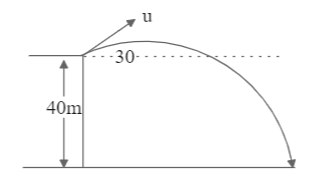
The figure shows a projectile thrown with speed

(A)
(B)
(C) 40 m
(D) 20 m

Answer
492.3k+ views
Hint:
Projectile motion occurs when an object is thrown with some velocity into the air. For this kind of motion, the components of the velocity with which the object is thrown determine the distance travelled in the horizontal and vertical direction, alike.
Formula used:
Complete step by step answer:
We have an object that is thrown from some height, making an angle with the horizontal. This object will eventually come down due to the influence of the gravitational acceleration, and we are required to find this distance.
The data that is provided to us includes:
Speed
Height in vertical direction
Angle made with the horizontal
We know that distance in vertical direction for projectile motion is given as:
The vertical component of the speed will be given by:
Substituting this in Eq. 1:
We take out commons to solve this quadratic equation as:
Solving for time t, we get:
Hence,
Now, we know that the horizontal range is given as:
So, inputting the values:
Hence, the correct answer is option (B).
Note:
The objects that experience projectile motion have a constant velocity in the horizontal direction, but a constantly changing velocity in the vertical direction. This combination results in the trajectory similar to that of a parabola. Projectile motion is mostly in sports like golf, baseball, cricket as the ball is hit into the air.
Projectile motion occurs when an object is thrown with some velocity into the air. For this kind of motion, the components of the velocity with which the object is thrown determine the distance travelled in the horizontal and vertical direction, alike.
Formula used:
Complete step by step answer:
We have an object that is thrown from some height, making an angle with the horizontal. This object will eventually come down due to the influence of the gravitational acceleration, and we are required to find this distance.
The data that is provided to us includes:
Speed
Height in vertical direction
Angle made with the horizontal
We know that distance in vertical direction for projectile motion is given as:
The vertical component of the speed will be given by:
Substituting this in Eq. 1:
We take out commons to solve this quadratic equation as:
Solving for time t, we get:
Hence,
Now, we know that the horizontal range is given as:
So, inputting the values:
Hence, the correct answer is option (B).
Note:
The objects that experience projectile motion have a constant velocity in the horizontal direction, but a constantly changing velocity in the vertical direction. This combination results in the trajectory similar to that of a parabola. Projectile motion is mostly in sports like golf, baseball, cricket as the ball is hit into the air.
Recently Updated Pages
Master Class 11 Economics: Engaging Questions & Answers for Success

Master Class 11 Business Studies: Engaging Questions & Answers for Success

Master Class 11 Accountancy: Engaging Questions & Answers for Success

Master Class 11 English: Engaging Questions & Answers for Success

Master Class 11 Computer Science: Engaging Questions & Answers for Success

Master Class 11 Maths: Engaging Questions & Answers for Success

Trending doubts
Which one is a true fish A Jellyfish B Starfish C Dogfish class 11 biology CBSE

State and prove Bernoullis theorem class 11 physics CBSE

1 ton equals to A 100 kg B 1000 kg C 10 kg D 10000 class 11 physics CBSE

In which part of the body the blood is purified oxygenation class 11 biology CBSE

One Metric ton is equal to kg A 10000 B 1000 C 100 class 11 physics CBSE

Difference Between Prokaryotic Cells and Eukaryotic Cells




